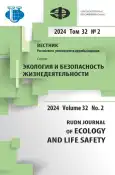High performance building ceramics based on solid waste
- 作者: Nemuschenko D.A.1, Larichkin V.V.1, Murav’ev M.T.1, Neustroev M.A.1
-
隶属关系:
- Novosibirsk State Technical University
- 期: 卷 32, 编号 2 (2024)
- 页面: 136-154
- 栏目: Industrial Ecology
- URL: https://journal-vniispk.ru/2313-2310/article/view/324084
- DOI: https://doi.org/10.22363/2313-2310-2024-32-2-136-154
- EDN: https://elibrary.ru/XIFGUI
- ID: 324084
如何引用文章
全文:
详细
The most important environmental problem of coal energy in Russia is the accumulation of solid waste in ash dumps - products of coal combustion. Ash dumps are located on the lands of populated areas and are source of toxic dust, contamination of surface and groundwater with soluble compounds and increased radioactivity. An effective solution to the problem of accumulation of ash and slag waste is its use as secondary raw materials in the construction industry. In this work, physicochemical methods were used to study ash and slag raw materials from coal-fired power plants in Novosibirsk and municipal cullet. Recipes for building ceramics have been developed by varying the content of fly ash and cullet, molding technologies, and modes of drying and firing of products. The influence of various methods of preparing raw materials (grinding, fractionation, ignition, mechanical activation) and methods of processing and dispersing ceramic masses on the physical and mechanical properties of experimental samples was studied. The possibility of obtaining ceramic products that meet the requirements of regulatory documents for construction materials is shown.
作者简介
Dmitry Nemuschenko
Novosibirsk State Technical University
编辑信件的主要联系方式.
Email: nemuschenko@corp.nstu.ru
ORCID iD: 0009-0000-8262-237X
SPIN 代码: 6213-1170
senior lector of Department of Engineering Problems of Ecology
20 Prospekt K. Marksa, Novosibirsk, 630073, Russian FederationVladimir Larichkin
Novosibirsk State Technical University
Email: larichkin@corp.nstu.ru
SPIN 代码: 6583-0412
doctor of engineering sciences, professor, Department of Engineering Problems of Ecology 20 Prospekt K. Marksa, Novosibirsk, 630073, Russian Federation
Mihail Murav’ev
Novosibirsk State Technical University
Email: misha_muravev_02@mail.ru
student 4 courses, Department of Engineering Problems of Ecology 20 Prospekt K. Marksa, Novosibirsk, 630073, Russian Federation
Maksim Neustroev
Novosibirsk State Technical University
Email: neustroev_maks@bk.ru
student 4 courses, Department of Engineering Problems of Ecology 20 Prospekt K. Marksa, Novosibirsk, 630073, Russian Federation
参考
- Kara-sal BK, Seren SHV. State and problems of production of ceramic wall materials using low-grade clay rocks. Vestnik TuvGU. 2015;3:7–12. (In Russ.)
- Sajbulatov SZH, Sulejmenov ST, Ralko AV. Ash-ceramic wall materials. Alma-Ata: Nauka, 1982. 292 p. (In Russ.)
- Barieva ER, Korolev EA, Egorova ES. Modeling the composition of a ceramic charge using ash and slag waste from Kazan TPS-2. News of universities. Energy problems. 2009;7-8:119–122. (In Russ.)
- Abdrahimov VZ, Hasaev GR, Abdrahimova ES, Kolpakov AV. Use of carbon-containing waste from the fuel and energy complex in the production of ceramic materials for various purposes. Ecology and industry of Russia. 2013;9:30–33. https://doi.org/10.18412/1816-0395-2013-9-30-33 (In Russ.)
- Abdrahimov VZ, Abdrahimova ES. Use of slag from the combustion of coal from the Kansk-Achinsk basin in the production of ceramic materials based on intershale clay. Ecology and industry of Russia. 2014;3:36–39. (In Russ.)
- Sidikova TD. Glass ceramics for the construction industry based on industrial waste. Modern construction and architecture. 2022;1:31–35. https://doi.org/10.18454/mca.2022.25.5 (In Russ.)
- Makarenko SV, Vasil'ev KO, Hohryakov OV, Hozin VG. Production of ash building ceramics based on ash and slag waste from thermal power plants in the Irkutsk region - an example of the best available technology for their disposal. Izvestiya KGASU. 2020;4(54):54–61. (In Russ.)
- YUr'ev IYU, Skripnikova NK, Volokitin OG. Study of the influence of modified ash and slag waste on the properties of fired ceramic products. Vestnik TGASU. 2013;4:191–196. (In Russ.)
- SHushkov DA, Burcev IN, Simakova YUS. Dense and porous ceramic materials from coal slurries of the Inta deposit. Glass and ceramics. 2022;95(4(1132)):29–38. https://doi.org/10.14489/glc.2022.04.pp.029-038 (In Russ.)
- Diana Mireya AV, Jairo Alberto GC, Judith R, Aldo RB. Development and Characterization of Glass-Ceramics from Combinations of Slag, Fly Ash, and Glass Cullet without Adding Nucleating Agents Materials. 2019;12:1–17. https://doi.org/10.3390/ma12122032
- Dash S, Panda L, Mohanty I, Gupta P. Comparative feasibility analysis of fly ash bricks, clay bricks and fly ash incorporated clay bricks. Magazine of civil engineering. 2022;7(115):11–20. https://doi.org/10.34910/MCE.115.2
- Larichkin VV, Vedyagin AA, Mishakov IV, Hlebnikov BM, Larichkin VV, Noskov AS. Physico-chemical study of ash and slag waste. Encyclopedia of a chemical engineer. 2008;10:21–26. (In Russ.)
- Nemuschenko DA, Larichkin VV. Research of ash waste from coal-fired power plants as a potential raw material for the construction industry. Expert: theory and practice. 2023;2(21):60–67. https://doi.org/10.51608/26867818-2023-2-60 (In Russ.)
- Storozhenko G.I. Technology for the production of wall ceramic products from activated clay raw materials: abstract of the dissertation for the doctor of technical sciences (05.23.08). TSABU. Tomsk; 2000. 44 p. (In Russ.)
- Poluboyarov VA, Andryushkova OV, Poluboyarov VA, Pauli IA, Korotaeva ZA. Mechanochemistry of creating materials with specified properties. NSTU. Novosibirsk; 2007. 352 p. (In Russ.)
- Zhu M, Ji R, Li Z, Wang H, Liu L, Zhang Z. Preparation of glass ceramic foams for thermal insulation applications from coal fly ash and waste glass. Construction and Building Materials. 2016;112:398–405. https://doi.org/10.1016/ j.conbuildmat.2016.02.183.
- Nemuschenko DA, Kal’neus VA, Kunicyna EA, Legotin AV, Slesarenko RA, Larichkin VV. Study of the influence of the addition of SiO2 nanopowder on the physical and mechanical properties of ash ceramics Promising materials. 2014;11:56–62. (In Russ.)
补充文件









